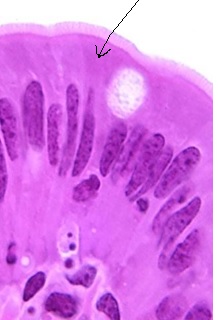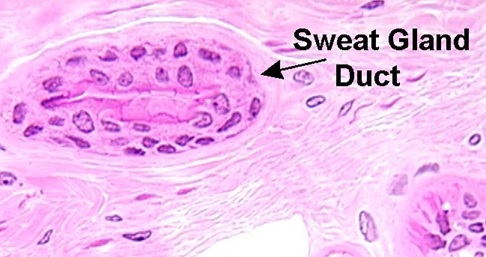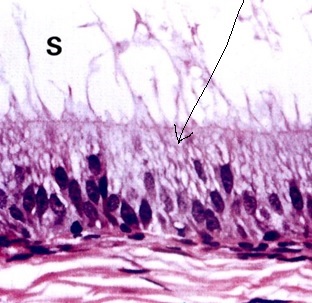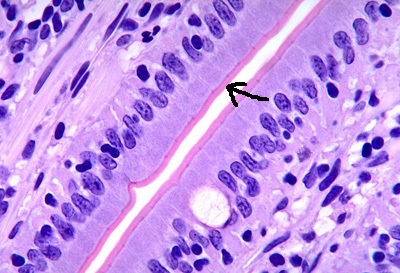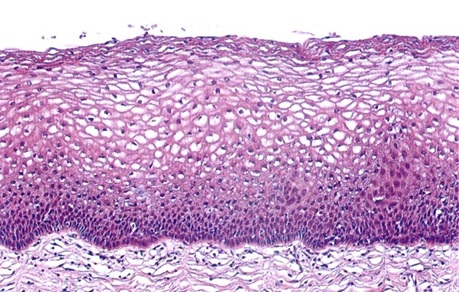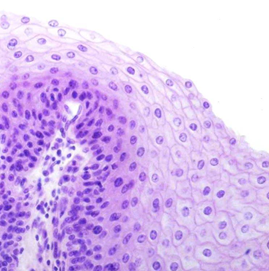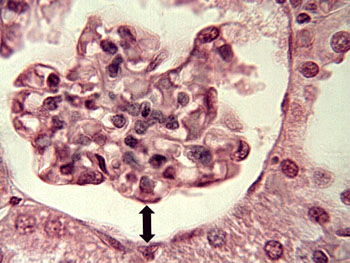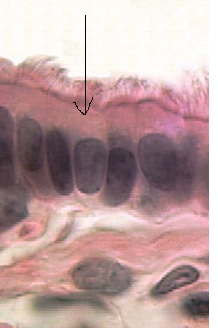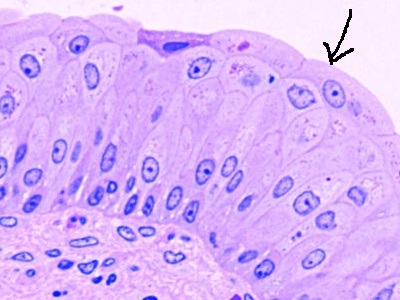BIOL 302 Epithelium Characterization Quiz

- 1.
Characterize the epithelium:
- A.
Transitional epithelium with cilia
- B.
Stratified columnar epithelium with cilia
- C.
Pseudostratified columnar epithelium with cilia
- D.
Pseudostratified columnar epithelium with stereocillia
Correct Answer
C. Pseudostratified columnar epithelium with ciliaExplanation
The given answer, pseudostratified columnar epithelium with cilia, is the correct characterization of the epithelium. Pseudostratified columnar epithelium refers to a type of epithelial tissue where the cells appear to be layered but are actually all in contact with the basement membrane. Cilia are present on the surface of the cells, which aid in movement and transportation of substances. This type of epithelium is commonly found in the respiratory tract, where the cilia help to move mucus and trapped particles out of the airways.Rate this question:
-
- 2.
Characterize the epithelium:
- A.
Stratified squamous epithelium
- B.
Simple squamous epithelium with keratin
- C.
Keratinized stratified squamous epithelium
- D.
Keratinized transitional epithelium
Correct Answer
C. Keratinized stratified squamous epitheliumExplanation
Keratinized stratified squamous epithelium is a type of tissue that consists of multiple layers of flat cells. The cells in this epithelium are covered with a tough protein called keratin, which provides protection against abrasion and dehydration. This type of epithelium is found in the outermost layer of the skin, known as the epidermis, as well as in the lining of the oral cavity, esophagus, and vagina. The presence of keratin makes the epithelium tough and resistant to damage, making it suitable for areas that experience mechanical stress and friction.Rate this question:
-
- 3.
Describe the epithelium:
- A.
Columnar epithelium with brush boarder
- B.
Simple columnar epithelium with goblet cell
- C.
Simple columnar epithelium with brush boarder
- D.
Stratified columnar epithelium with brush boarder
Correct Answer
C. Simple columnar epithelium with brush boarderExplanation
The correct answer is simple columnar epithelium with brush border. This type of epithelium is characterized by a single layer of column-shaped cells that are taller than they are wide. The cells have microvilli on their apical surface, which form a brush border. This brush border increases the surface area of the cells and aids in absorption and secretion. Simple columnar epithelium with a brush border is commonly found in the lining of the small intestine, where it helps with nutrient absorption.Rate this question:
-
- 4.
Characterize the epithelium:
- A.
Stratified columnar epithelium with cilia
- B.
Pseudostratified cuboidal epithelium
- C.
Simple cuboidal epithelium
- D.
Stratified cuboidal epithelium
Correct Answer
D. Stratified cuboidal epitheliumExplanation
The given answer, stratified cuboidal epithelium, is the correct characterization of the epithelium. This type of epithelium consists of multiple layers of cuboidal cells. It is typically found in sweat glands, salivary glands, and the male urethra. The presence of multiple layers of cells provides protection and support to the underlying tissues.Rate this question:
-
- 5.
Characterize the epithelium:
- A.
Pseudostratified columnar epithelium with stereocillia
- B.
Pseudostratified columnar epithelium with cillia
- C.
Stratified columnar epithelium with stereocillia
- D.
Stratified columnar epithelium with cillia
Correct Answer
A. Pseudostratified columnar epithelium with stereocilliaExplanation
The correct answer is pseudostratified columnar epithelium with stereocillia. Pseudostratified columnar epithelium refers to a type of tissue in which the cells appear to be layered or stratified, but all cells are in contact with the basement membrane. Stereocilia are long, non-motile microvilli that are found in certain epithelial tissues, such as the epididymis and the inner ear. Therefore, the presence of stereocillia in this type of epithelium is the distinguishing characteristic.Rate this question:
-
- 6.
Characterize the epithelium:
- A.
Columnar epithelium with cillia
- B.
Columnar epithelium with microvilli
- C.
Cuboidal epithelium with brush boarder
- D.
Simple columnar epithelium with microvilli
Correct Answer
D. Simple columnar epithelium with microvilliExplanation
The correct answer is simple columnar epithelium with microvilli. This means that the epithelium is composed of a single layer of column-shaped cells and these cells have microvilli on their surface. Microvilli are small finger-like projections that increase the surface area of the cells, allowing for better absorption and secretion. Simple columnar epithelium with microvilli is commonly found in the lining of the digestive tract, where it aids in the absorption of nutrients.Rate this question:
-
- 7.
Characterize the epithelium:
- A.
Stratified squamous epithelium with keratin
- B.
Stratified squamous epithelium with brush boarder
- C.
Stratified squamous epithelium with basal bodies
- D.
Stratified squamous epithelium
Correct Answer
D. Stratified squamous epitheliumExplanation
The correct answer is stratified squamous epithelium. This type of epithelium consists of multiple layers of flat cells. It is found in areas of the body that experience a lot of wear and tear, such as the skin, mouth, and esophagus. The stratified nature of this epithelium allows for protection against mechanical stress and abrasion. The absence of any additional descriptors such as keratin, brush border, or basal bodies suggests that the epithelium in question is a simple stratified squamous epithelium without any specialized features.Rate this question:
-
- 8.
Characterize the epithelium:
- A.
Stratified squamous epithelium
- B.
Stratified squamous epithelium with keratin
- C.
Transitional squamous epithelium
- D.
Transitional epithelium
Correct Answer
A. Stratified squamous epitheliumExplanation
The correct answer is stratified squamous epithelium. This type of epithelium consists of multiple layers of flat cells. It is found in areas that undergo a lot of wear and tear, such as the skin and the lining of the mouth and esophagus. The presence of multiple layers of cells helps to protect underlying tissues from damage.Rate this question:
-
- 9.
Characterize the epithelium that the arrows are pointing to:
- A.
Simple squamous
- B.
Endothelium
- C.
Simple squamous epithelium
- D.
Mesothelium
Correct Answer
C. Simple squamous epitheliumExplanation
The correct answer is simple squamous epithelium. This type of epithelium is characterized by a single layer of flat, scale-like cells that are tightly packed together. It is found in areas where diffusion and filtration are important, such as the lining of blood vessels and air sacs in the lungs. The arrows in the question are pointing to a tissue that appears to have a single layer of flat cells, which is consistent with the characteristics of simple squamous epithelium.Rate this question:
-
- 10.
Characterized the epithelium:
- A.
Simple columnar with cilia
- B.
Ciliated simple columnar epithelium
- C.
Elongated cuboidal epithelium with cilia
- D.
Simple columnar epithelium with stereocilia
Correct Answer
B. Ciliated simple columnar epitheliumExplanation
The correct answer is ciliated simple columnar epithelium. This type of epithelium is characterized by its columnar shape and the presence of cilia on its surface. The cilia help in the movement of substances across the epithelial surface. The term "ciliated" indicates the presence of cilia, while "simple columnar" describes the shape of the cells. Therefore, the answer "ciliated simple columnar epithelium" accurately describes the characteristics of the epithelium.Rate this question:
-
- 11.
Characterize the epithelium:
- A.
Stratified low cuboidal epithelium
- B.
Stratified transitional epithelium
- C.
Stratified squamous epithelium
- D.
Transitional epithelium
Correct Answer
D. Transitional epitheliumExplanation
Transitional epithelium is the correct answer because it is a type of stratified epithelium that is found in organs that need to stretch and accommodate changes in volume, such as the urinary bladder. It is characterized by multiple layers of cells that can change shape from cuboidal to squamous, allowing it to stretch and contract without tearing. This type of epithelium is specialized for its unique function of maintaining tissue integrity while accommodating changes in volume.Rate this question:
-
Quiz Review Timeline +
Our quizzes are rigorously reviewed, monitored and continuously updated by our expert board to maintain accuracy, relevance, and timeliness.
-
Current Version
-
Mar 21, 2023Quiz Edited by
ProProfs Editorial Team -
Sep 21, 2014Quiz Created by
Stpmcgin
 Back to top
Back to top



.jpg)
